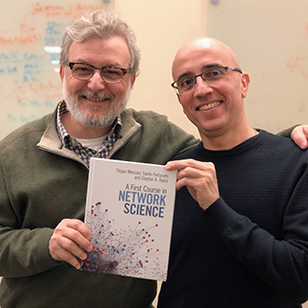
Fil Menczer (left) and Santo Fortunato
Luddy School of Informatics, Computing, and Engineering professors Santo Fortunato and Fil Menczer are co-authors of the new book, “A First Course in Network Science,” the first undergraduate textbook in the field on network science.
Written with fellow co-author Clayton Davis, who earned his Ph.D. in informatics from Luddy in 2019, the book introduces the basics of network science for a wide range of job sectors from management to marketing, from biology to engineering, and from neuroscience to the social sciences. It will teach students how to develop important, practical skills and learn to write code for using networks in their areas of interest - even as they are just learning to program with Python.
“We have been teaching network science for several years at Indiana University to a broad audience of undergraduate students in informatics, computer science, data science, information science, business, and the natural and social sciences,” said Menczer, a professor of computer science and informatics at Luddy. “This experience has taught us that students are eager to ‘get their hands dirty’ and write code to both understand and use networks in their application domains of interest even as they are just learning to program and lack a math and computing background beyond high school and entry-level college courses. There was no introductory textbook covering network science from this perspective and targeting such a wide audience of students with a willingness to learn by doing. So, we developed the book alongside a wide set of tutorials and problems that provide learners with lots of hands-on practice.”
The idea for the book had been brewing for years. Material was generally written for a narrow audience of researchers, but Fortunato and Menczer believed there was a need to serve a more general audience. The rise of social media in recent years has made the demand for such a textbook more apparent.
“With the explosion of popularity and commercial success of online social media, many students are interested in learning a bit about what is ‘under the hood’ of networks,” Fortunato said. “The book goes into how networks are present in all aspects of our lives: networks of friends, communication, computers, the Web, and transportation are examples that we experience outwardly, while our brain cells and the proteins within our body form networks that determine our survival and intelligence. When people communicate through Facebook or Twitter, buy stuff on Amazon, search on Google, or buy an air ticket to visit family, they use networks without knowing it. Today, a basic understanding of network processes is required. This textbook explores how networks help us understand the complex patterns of relationships that shape our lives.”
“A First Course in Network Science” is published by Cambridge University Press and has been ranked as one of the top new releases in mathematical physics by Amazon.

